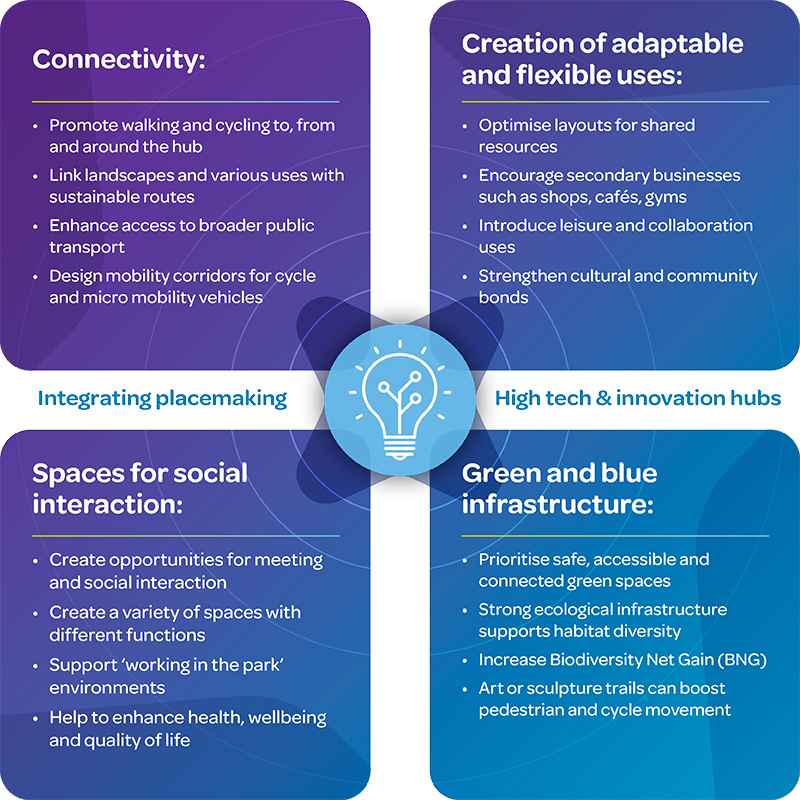Comment
Adding value to high tech and innovation hubs through placemaking
Can placemaking catalyse the evolution of out of town employment parks to holistically integrated, sustainable places offering social, economic and environmental benefits?
Look at any science and technology park (formerly business and employment parks) from the latter part of the 20th Century and a common theme emerges: isolated ‘silos’ built around the car with large, faceless buildings surrounded by expansive parking with little or no provision for recreation, meeting with others or socialising.
Over recent years, approach to development – particularly residential - has changed significantly, with a strong focus on placemaking and putting people, not vehicles, first. The National Model Design Code, National Design Guide and National Planning Policy Framework (NPPF) all set out principles and criteria for well-designed sustainable communities which can easily be adapted and applied to other sectors, including high tech and innovation hubs.
Why placemaking for high tech and innovation hubs?
- Evolving work-life dynamics: The way people work and live has become more fluid, with a growing need for multifunctional spaces
- Futureproofed sustainability: Creating sustainable development which can adapt and change for future needs
- Encouraging collaboration: Create opportunities for innovators, entrepreneurs, academics, scientists and engineers to collaborate, with spaces that encourage meaningful interactions
- Magnetising top talent: Attract and retain a talented and skilled workforce through dynamic, interconnected hubs with supporting uses that encourage reciprocal relationships
- Prioritising wellbeing: Elevating both mental and physical health is key, helping to enhance productivity and creativity
How can we achieve this?

The consideration and emphasis of ‘Place’ through:
- Connectivity: Encourage walking and cycling to, from and around the development through sustainable movement routes which connect various uses and areas of landscape. Consider and improve access to the wider area and broader public transport network to reduce the use of the car and support accessibility for local employees. Mobility corridors could accommodate cycle and micro mobility vehicles, separate from pedestrians and runners.
- Creation of adaptable and flexible uses: Consideration of layout to seek opportunity for shared resources. Bringing people together creates opportunity for secondary support businesses and facilities, such as shops, cafés, gyms and nurseries. The introduction of complimentary uses to support the area, such as through leisure and collaboration hubs, can strengthen cultural and community infrastructure, whilst boosting collaboration and innovation.
- Spaces for social interaction: Create opportunities for meeting and social interaction through a variety of spaces with different functions, providing opportunities for recreation, activity and supporting the ‘working in the park’ concept. These environments enhance health and wellbeing and increase quality of life.
- Green and blue infrastructure: Safe, accessible and connected green spaces create consolidated development parcels enclosed by strong buffers. Strong ecological infrastructure can support habitat diversity and increase Biodiversity Net Gain (BNG). Opportunities for sculpture or art trails can encourage pedestrian and cycle movement through the site.
Our Design team has extensive experience in this area of work and understand the added value, both in a commercial and social sense, that placemaking can add. Masterplanning allows us to consider the overall approach, including clustering of uses, green and blue infrastructure, connectivity, active transport and amenity hubs.
Learn more about our technology, energy and innovation expertise and the ways this has influenced masterplanning to evolve the discipline.
For more information or to discuss opportunities for collaboration, please contact Debbie Clutton or Sarah Morgan.
19 October 2023